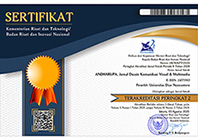Pencapaian Sense of Design dalam Perancangan Desain Komunikasi Visual
DOI:
https://doi.org/10.33633/andharupa.v2i02.1211Abstract
AbstrakPenelitian ini membahas tentang kekuatan rasa dalam perancangan desain komunikasi visual. Aktualisasi komukasi visual tidak dapat lepas dari bisnis dan estetika desain. Rasa berperan penting dalam perancangan, jika tidak akan terjadi risalah tragedi. Karya-karya perancangan komunikasi visual tidak bisa lepas dari media sebagai tempat mediasi antara produk, jasa, bahkan aktualisasi diri dengan masyarakat yang menjadi sasaran. Kehadiran rasa pada setiap unsur di dalam perancangan akan membingkai konsep dari suatu rancangan. Metode penelitian menggunakan kualitatif yang lebih menekankan pada observasi dan dokumentasi. Analisis data menggunakan analisis studi kasus. Berkreasi dengan rasa adalah persoalan penghayatan, karena setiap tindakan yang dilakukan manusia melibatkan seluruh panca indra. Penghayatan melalui daya imajinasi yang terwujud secara visual adanya stilasi, distorsi, dan adaptasi. Namun yang menarik adalah perancang mampu menangkap esensi, sehingga rasa lebih dilibatkan pada proses penciptaan. Rasa dalam perancangan adalah hasil dari penghayatan yang di dalamnya menunjukkan adanya kegiatan berproses kreatif. Aspek kreatif, ekspresi, persepsi, karakter, produktif, inventif, inovasi, dan inspirasi serta emergentif yang keseluruhan hadir dalam konsep perancangan tertuju pada pencapaian nilai estetika. Perancangan komunikasi visual menunjukkan adanya rasa dari proses hingga final desain. Rasa dalam perancangan komunikasi visual hadir pada setiap elemen desain yaitu: ilustrasi, tipografi, warna, dan layout.  Kata kunci: Sense of Design, Elemen Desain, Desain Komunikasi Visual. AbstractThis research discuss about the power of sense in creation of Visual Communication Design. The actualization of visual communication can’t be separated from bussines and aesthetic design. The sense is important role in creation. If it doesn’t, it will be treatise tragedy. The product of visual communication can’t be separated from media, as a mediation place among product, services, even self actualization with social community who became target. The presence of sense on every element in the design will frame the concept of design. Research methods uses a qualitative approach with emphasis on observation and documentation. The analize data uses case study. Creating with sense is appreciation problems, because every action of human involve all five senses. The appreciation through the imagination manifested visually may experience stylized, distortion, and adaptation. But interestingly, designer is able to capture the essence, so the sense be more involved in the creation process. The sense of design is the result of the appreciation that includes creative activity. The creative, expression, perception, character, productive, inventive, innovation, inspiration, and emergentif aspects that present in the overall design concept focused on achieving aesthetic value. The design of visual communications show the sense of the process until the final design. The sense of design is present in every element of the design such as illustration, typography, color, and layout.Keywords : Sense of Design, Element Design, Visual Communication DesignReferences
Creswell, John W. 1998. Qualitative Inquiry and Research Design. California: SAGE Publication. Inc.
Damajanti, Irma. 2006.Psikologi Seni Sebuah Pengantar. Bandung: Kiblat.
Handinoto, Noor. 2014. “Perancangan Media promosi Green Oase Residence di Kota Semarang†Tugas Akhir. Semarang: Universitas Dian Nuswantoro.
Huda, Miftakhul. 2014. “Perancangan Kemasan Pada Produk Dodol Aneka Rasa Citra Persada Kudusâ€. Tugas Akhir. Semarang: Universitas Dian Nuswantoro
Kusmayati, A.M. Hermien. (ed). 2003. Kembang Setaman: Persembahan untuk Sang Mahaguru. Yogyakarta: BP ISI Yogyakarta. Ada dimanakah kutipan ini?
Lukitasari, Evelyne Henny. 2013. “Komunikasi Visual pada Kemasan Besek Makanan oleh-oleh Khas Banyumasâ€. Jurnal Dewa Ruci. Vol. 8. No. 3. Desember 2013. Surakarta: ISI Surakarta.
Frascara, Jorge. 2004. Intoduction Enginering Design and Graphic, America: Printed in the USA.
Tim Penyusun Kamus Pusat Bahasa. 2008. Kamus Bahasa Indonesia. Jakarta: Pusat Bahasa.
Kasiyan. 2006. “Media di Era Budaya Massa: Tegangan antara Berkah dan Bencana Bagi Humanioraâ€. Jurnal Ornamen. Vol. 3 No. 1. Januari 2006. Surakarta: ISI Surakarta.
Mihaly, Csikszentmihalyi. 1996. Creativity: Flow and the Psychology of Discovery and Invention. New York: Harper Perennial,.
Pujianto. 2015. “Above The Line: Estetik Simbolik Advertorialâ€. Paper. Tidak diterbitkan.
Rifai, Ahmad. 2014. “Perancangan Media Promosi Mega Rozaq Tour Semarangâ€. Tugas Akhir. Semarang: Universitas Dian Nuswantoro
Russel, J. Thomas dan Lane, W. Roland. 1992. Kleppner’s Advertising Procedure (fifteenth edition). USA: Prentice Hell.
Rustan, Surianto. 2008. Layout Dasar dan Penerapannya, Jakarta: PT Gramedia Pustaka Utama.
Stafila, Monicha. 2014. “Perancangan media promosi girls on top Dengan pendekatan equal genderâ€. Tugas Akhir. Semarang: Universitas Dian Nuswantoro.
Wijaya, Priscilia Yunita. 1999. “Tipografi Dalam Desain Komunikasi Visualâ€. Jurnal Nirmana. Vol.1. No. 1 Januari 1999. Surabaya: Universitas Kristen Petra.
Downloads
Published
Issue
Section
License
Copyright (c) 2016 ANDHARUPA: Jurnal Desain Komunikasi Visual & Multimedia

This work is licensed under a Creative Commons Attribution 4.0 International License.
Authors who publish with this journal agree to the following terms:
- Authors retain copyright and grant the journal right of first publication with the work simultaneously licensed under a Creative Commons Attribution License that allows others to share the work with an acknowledgment of the work's authorship and initial publication in this journal.
- Authors are able to enter into separate, additional contractual arrangements for the non-exclusive distribution of the journal's published version of the work (e.g., post it to an institutional repository or publish it in a book), with an acknowledgment of its initial publication in this journal.
- Authors are permitted and encouraged to post their work online (e.g., in institutional repositories or on their website) prior to and during the submission process, as it can lead to productive exchanges, as well as earlier and greater citation of published work (See The Effect of Open Access).















